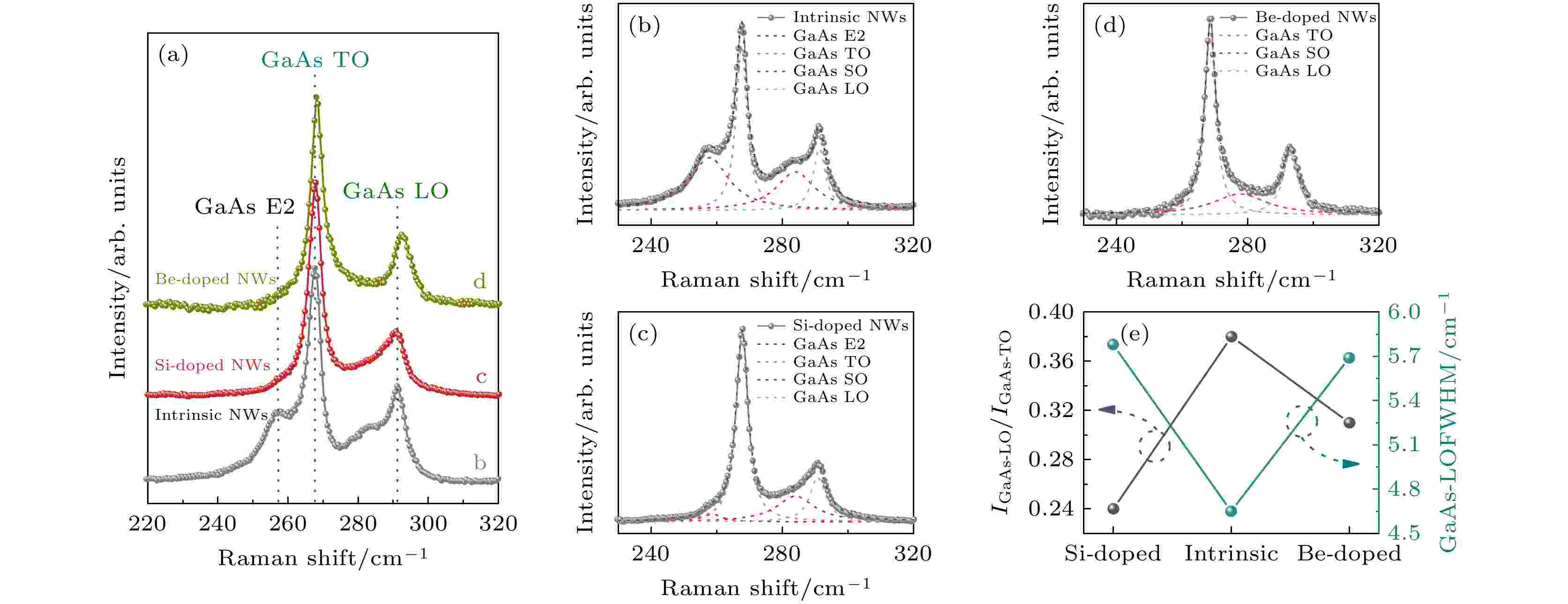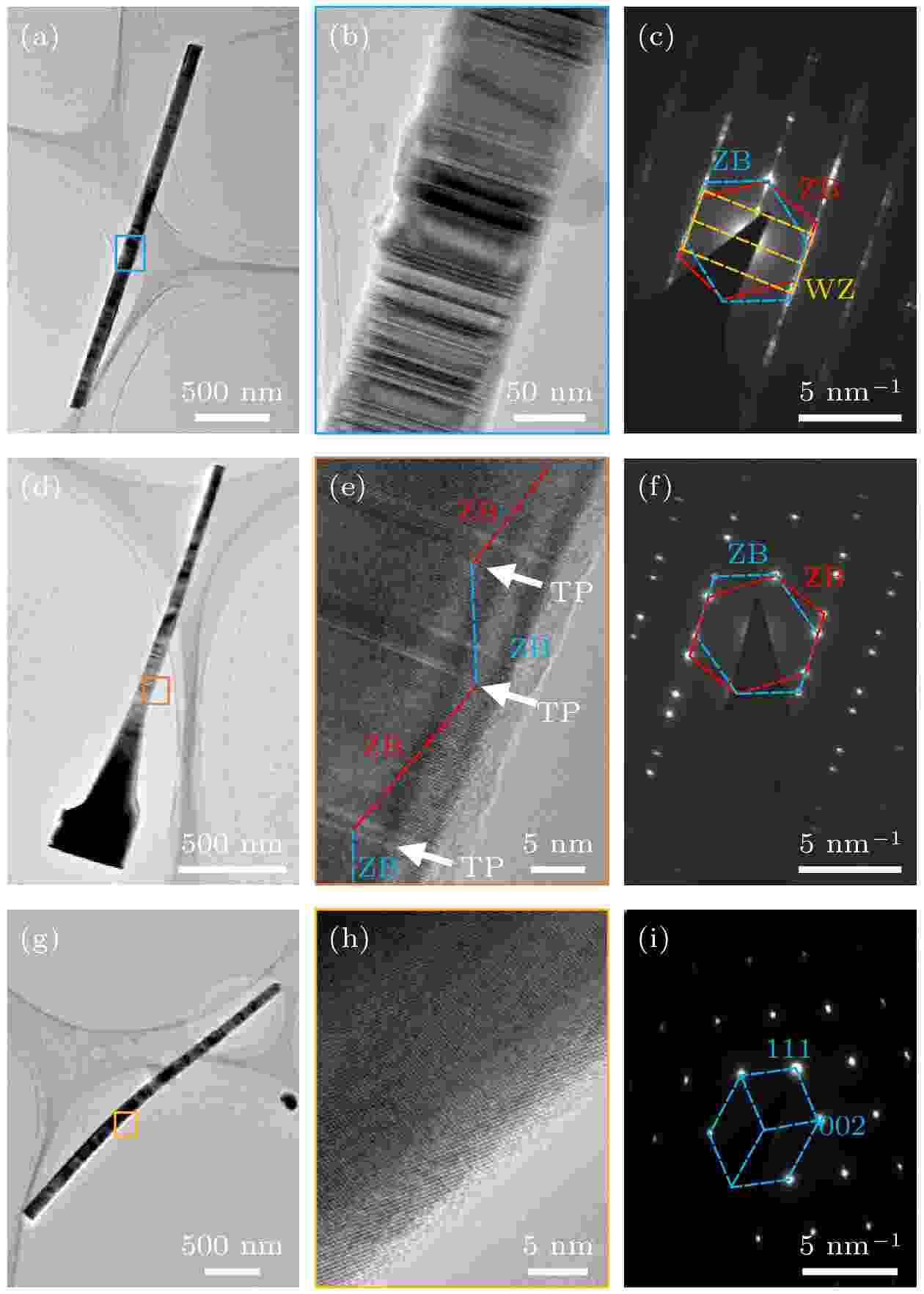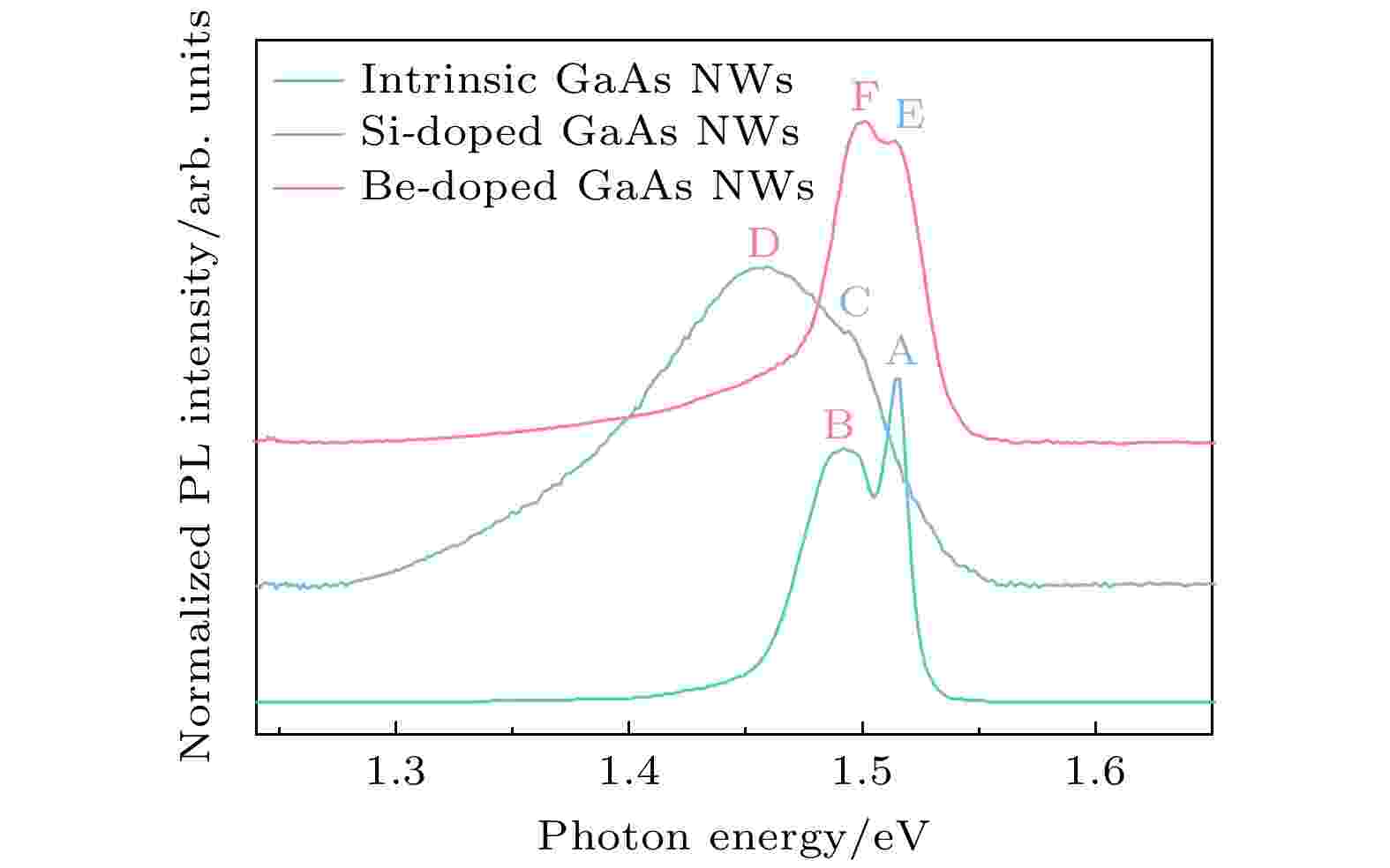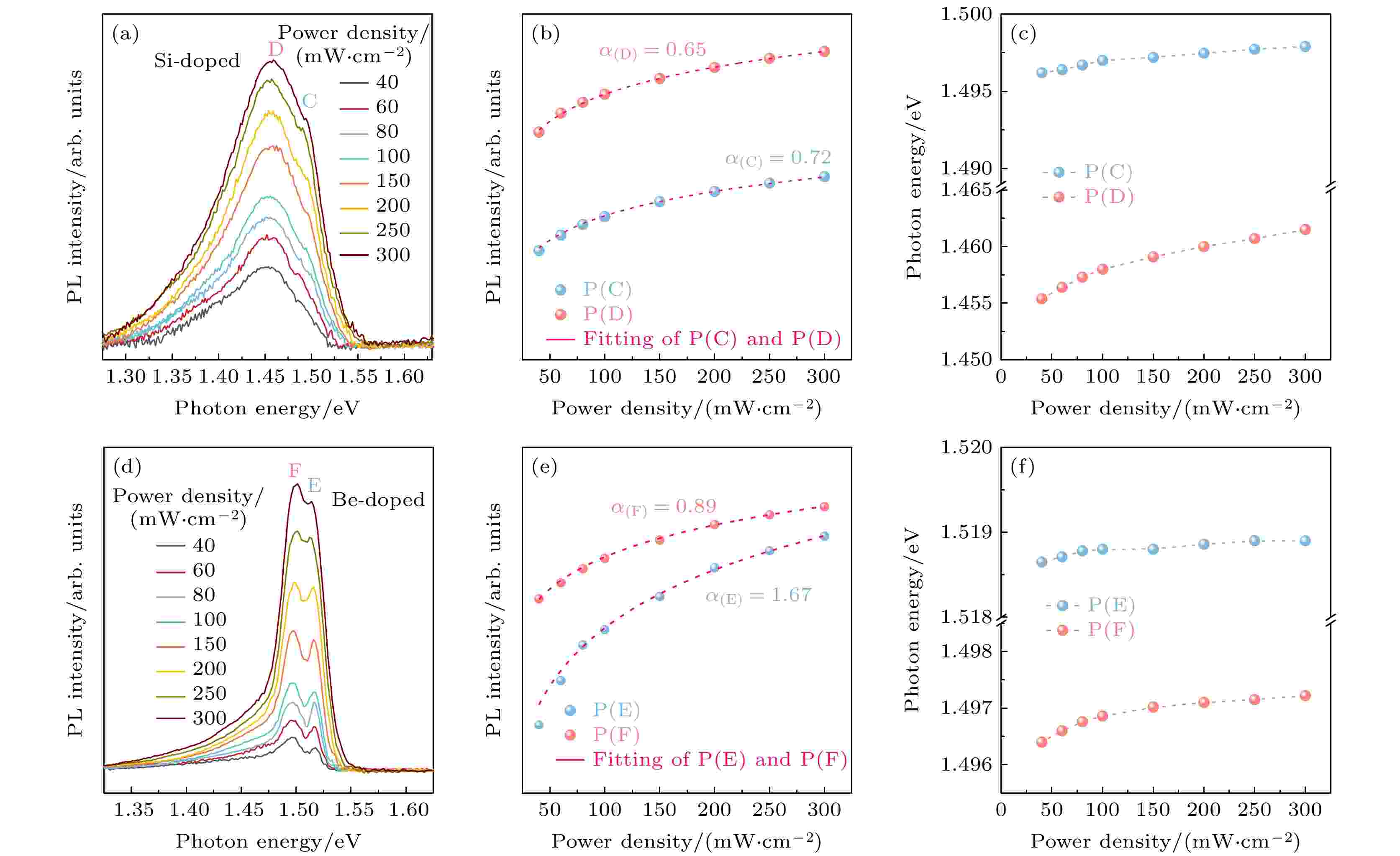全文HTML
--> --> -->近几年, 大量研究工作致力于开发将WZ/ZB混相结构转变为纯相ZB或者WZ结构生长工艺. 主要是通过控制纳米线的生长条件和表面能(生长温度[9], V/III比率[10]和液滴的形状[11,12], 引入Sb合金[13,14], 掺杂[15-17]等)实现单一相. 大多数报道局限在纳米线的结构控制, 对其光学特性研究相对较少. 尤其是对通过不同杂质掺杂GaAs纳米线的发光来源有待深入研究.
本文采用超高真空分子束外延(molecular beam epitaxy, MBE)结合自催化的生长方式制备了本征、Si掺杂和Be掺杂GaAs纳米线, 对其结构和光学特性进行分析. Raman光谱显示本征GaAs纳米线存在一个明显的WZ结构特有的E2模式峰, 掺杂GaAs纳米线的E2模式峰明显减弱甚至消失. GaAs纳米线的高分辨透射电镜(high-resolution transmission electron microscope, HRTEM)及选区电子衍射(selected area electron diffraction, SAED)显示掺杂可以明显降低WZ结构的密度, 使得WZ/ZB(本征GaAs纳米线)混相结构转变为ZB(掺杂GaAs纳米线)结构. 在此基础上对其光学特性研究, 光致发光(photoluminescence, PL)光谱发现本征、Si掺杂和Be掺杂GaAs纳米线都存在两个主要的发光峰. 本征GaAs纳米线发光源于自由激子发光和II-型结构的发光, Si掺杂GaAs纳米线发光来源为导带到受主的发光及施主受主对的发光, Be掺杂GaAs纳米线发光来源为自由激子及导带到受主的发光. 低温PL光谱对比显示, 光谱成分由掺杂前WZ/ZB混相结构的发光转变为以掺杂后杂质缺陷相关的发光为主导.
用场发射扫描电镜(scanning electron microscopy, SEM, 日立FE-S4800)对生长的样品的形貌进行表征, 获得GaAs纳米线的形貌. 采用LabRAM HR Evolution, HORIBA光谱仪获得GaAs纳米线的Raman光谱, 通过WZ结构的特征模式峰E2来确定GaAs纳米线结构[18-21], 其中激光器波长为532 nm. 通过高分辨透射电镜(HRTEM, FEI Tecnai G2-F20)及配套的选区电子衍射(SAED)进一步确定GaAs纳米线的晶体结构. 采用HORIBA iHR550光谱仪进行低温变功率PL光谱测试, 使用655 nm半导体二极管激光器作为激发源, 光斑大小约为0.4 cm2.
 图 1 GaAs纳米线SEM侧视图 (a)本征GaAs纳米线; (b) Si掺杂GaAs纳米线; (c) Be掺杂GaAs纳米线
图 1 GaAs纳米线SEM侧视图 (a)本征GaAs纳米线; (b) Si掺杂GaAs纳米线; (c) Be掺杂GaAs纳米线Figure1. The side-view SEM images of GaAs NWs: (a) Intrinsic GaAs NWs; (b) Si-doped GaAs NWs; (c) Be-doped GaAs NWs.
 图 2 (a)本征, Si掺杂及Be掺杂GaAs纳米线的Raman光谱; (b)本征, (c) Si掺杂和(d) Be掺杂GaAs纳米线的多洛伦兹拟合图; (e)所有GaAs纳米线的GaAs LO与GaAs TO强度比值及GaAs LO的FWHM图
图 2 (a)本征, Si掺杂及Be掺杂GaAs纳米线的Raman光谱; (b)本征, (c) Si掺杂和(d) Be掺杂GaAs纳米线的多洛伦兹拟合图; (e)所有GaAs纳米线的GaAs LO与GaAs TO强度比值及GaAs LO的FWHM图Figure2. (a) The Raman spectra of intrinsic, Si-doped and Be-doped GaAs NWs; (b) intrinsic, (c) Si-doped, and (d) Be-doped GaAs NWs are fitted by multi-Lorentzian functions; (e) intensity ratio of ILO/ITO and FWHM of GaAs LO for intrinsic, Si-doped and Be-doped GaAs NWs.
为了更清楚地阐明本征、Si掺杂和Be掺杂GaAs纳米线的晶体结构, 对其进行TEM测试, 如图3所示. 图3(a)—(c)是本征GaAs纳米线的低分辨TEM、高分辨TEM及对应的选区电子衍射图样. 本征GaAs纳米线的选区电子衍射图样存在三套衍射斑, 两套来自于ZB结构, 一套来自于WZ结构. ZB结构的衍射斑通过蓝色和红色虚线标记, 而WZ结构的衍射斑通过黄色虚线标记. 因此可以得到本征GaAs纳米线为WZ/ZB混相结构且存在大量的缺陷. 通过低分辨TEM、高分辨TEM及对应选区电子衍射图样表征Si掺杂GaAs纳米线的晶体结构, 如图3(d)—(f)所示. 图3(e)显示Si掺杂GaAs纳米线为ZB结构, 且存在多个孪晶面(twin planes, TP), 通过白色箭头标记. 图3(f)显示了两套ZB结构对应电子衍射斑, 分别被蓝色和红色虚线标记, 因此可以得到Si掺杂GaAs纳米线为纯相ZB结构. 通过低分辨TEM, HRTEM和选区电子衍射图样对Be掺杂GaAs纳米线的晶体结构进行表征, 如图3(g)—(i)所示. HRTEM及选区电子衍射图样显示Be掺杂GaAs纳米线为ZB结构. 因此, 掺杂实现了GaAs纳米线的相控制, 这与Raman光谱测试结果一致.
 图 3 GaAs纳米线的TEM和选区电子衍射图. 本征GaAs纳米线 (a)低分辨TEM, (b)高分辨TEM及(c)对应的选区电子衍射图样; Si掺杂GaAs纳米线(d)低分辨TEM, (e)高分辨TEM及(f)对应的选区电子衍射图样; Be掺杂GaAs纳米线(g)低分辨TEM, (h)高分辨TEM及(i)对应的选区电子衍射图样
图 3 GaAs纳米线的TEM和选区电子衍射图. 本征GaAs纳米线 (a)低分辨TEM, (b)高分辨TEM及(c)对应的选区电子衍射图样; Si掺杂GaAs纳米线(d)低分辨TEM, (e)高分辨TEM及(f)对应的选区电子衍射图样; Be掺杂GaAs纳米线(g)低分辨TEM, (h)高分辨TEM及(i)对应的选区电子衍射图样Figure3. TEM and SAED of GaAs NWs: (a) Low-TEM, (b) HRTEM and (c) SAED of intrinsic GaAs NW; (d) low-TEM, (e) HRTEM and (f) SAED of Si-doped GaAs NW; (g) low-TEM, (h) HRTEM and (i) SAED of Be-doped GaAs NW.
在此基础上, 研究掺杂对GaAs纳米线光学特性的影响. 图4显示了本征、Si掺杂和Be掺杂GaAs纳米线的低温(10 K)光致发光光谱. 本征GaAs纳米线的PL光谱显示两个主要的发光峰, 标记为A和B, 对应的波长(能量)分别为818.4 nm (1.515 eV)和831.1 nm (1.492 eV). 立方相ZB结构的GaAs体材料激子跃迁峰位(能量)约为816.3 nm (1.519 eV). Si掺杂GaAs纳米线的PL光谱显示明显的展宽峰, 且包含两个主要的发光峰, 标记为C和D, 对应的波长(能量)分别是828.8 nm (1.496 eV)和848.7 nm (1.461 eV). 另外, Be掺杂GaAs纳米线的PL光谱也显示两个明显的发光峰, 标记为E和F, 对应的峰位分别是816.4 nm (1.519 eV)和828.3 nm (1.497 eV).
 图 4 本征, Si掺杂和Be掺杂GaAs纳米线的低温(at 10 K)下光致发光光谱, 激发光源的功率密度为300 mW/cm2
图 4 本征, Si掺杂和Be掺杂GaAs纳米线的低温(at 10 K)下光致发光光谱, 激发光源的功率密度为300 mW/cm2Figure4. The PL spectra of intrinsic, Si-doped and Be-doped GaAs NWs at low temperature (10 K). The power density of the excitation light source is 300 mW/cm2.
为了确定本征GaAs纳米线的发光来源, 本文进行低温变功率光谱测试(图5). 图5(a)显示随着功率密度的增加, 峰P(A)的峰位没有变化, 而峰P(B)的峰位随着功率密度的增加存在小幅度的蓝移, 该现象是由II-型能带弯曲效应所引起[24,25]. 峰P(A)和P(B)的积分强度与激发功率密度之间的关系如(1)式所示[25,26]:
 图 5 本征GaAs纳米线光谱图 (a)本征GaAs纳米线在不同功率密度下的PL光谱曲线; (b)本征GaAs纳米线中峰P(A)和峰P(B)强度随功率密度的关系曲线; (c) P(A)和P(B)峰位和功率1/3(P1/3)的关系曲线
图 5 本征GaAs纳米线光谱图 (a)本征GaAs纳米线在不同功率密度下的PL光谱曲线; (b)本征GaAs纳米线中峰P(A)和峰P(B)强度随功率密度的关系曲线; (c) P(A)和P(B)峰位和功率1/3(P1/3)的关系曲线Figure5. The PL spectra of intrinsic GaAs NWs: (a) The PL spectral curves of intrinsic GaAs NWs at different power density; (b) the relationship between peak P (A) and P (B) intensity with power density in intrinsic GaAs NWs; (c) the relationship between P(A) and P(B) peaks and P1/3.

对GaAs纳米线进行掺杂, 对应的发光峰出现明显的变化, Si掺杂和Be掺杂GaAs纳米线低温(at 10 K)下变功率测试结果如图6所示. 从图6(a)中可以看到Si掺杂GaAs纳米线的强度随着功率密度的增加而增加, 但对应的峰形没有出现明显的变化. 为了更好地确定对应的两个峰P(C)和P(D)的发光来源, 对其变功率光谱进行高斯拟合, 同时建立功率密度与积分强度之间的关系((1)式), 对应的α值分别为0.72和0.65, 如图6(b)所示, 因此可以确定峰P(C)和峰P(D)为缺陷或者杂质之间的发光. Arab等[28]报道的Si掺杂GaAs纳米线的发光峰对应的峰位为1.496, 1.488, 1.469和1.460 eV, 这些峰源于Si杂质相关的发光. 本文中Si掺杂GaAs纳米线低温PL光谱对应的峰位为1.496 eV和1.461 eV, 因此Si掺杂GaAs纳米线的发光峰源于Si杂质缺陷. 为了更进一步确定其发光来源, 构建功率密度与两个发光峰峰位之间的关系, 如图6(c)所示. 从图中可以发现, 峰P(C)随着激发功率密度的增加, 峰位轻微的蓝移, 峰P(C)为导带到受主的发光[29,30]. 同时随着功率密度的增加, 1.461 eV发光峰位出现明显的蓝移现象, 这种现象与施主-受主对(DAP)辐射复合发光相似. DAP辐射复合的峰位可以被描述[29,31-33]为
 图 6 掺杂GaAs纳米线的光谱图 (a)不同功率密度下Si掺杂GaAs纳米线的PL光谱曲线; Si掺杂GaAs纳米线中P(C)和P(D)积分强度(b)和峰位(c)随功率密度的关系曲线; (d)不同功率密度下Be掺杂GaAs纳米线的PL光谱曲线; Be掺杂GaAs纳米线中P(E)和P(F)峰积分强度(e)和峰位(f)随功率密度的关系曲线
图 6 掺杂GaAs纳米线的光谱图 (a)不同功率密度下Si掺杂GaAs纳米线的PL光谱曲线; Si掺杂GaAs纳米线中P(C)和P(D)积分强度(b)和峰位(c)随功率密度的关系曲线; (d)不同功率密度下Be掺杂GaAs纳米线的PL光谱曲线; Be掺杂GaAs纳米线中P(E)和P(F)峰积分强度(e)和峰位(f)随功率密度的关系曲线Figure6. The PL spectra of doped GaAs NWs: (a) The PL spectral curves of Si-doped GaAs NWs at different power density; the relationship between P (C) and P (D) integral intensity (b) and peak positions (c) with power density in Si-doped GaAs NWs; (d) the PL spectral curves of Be-doped GaAs NWs at different power density; The relationship between P (E) and P (F) peak integral intensity (e) and peak positions (f) with power density in Be-doped GaAs NWs.
对于Be掺杂GaAs纳米线的低温PL光谱测试, 图6(d)显示峰P(E)和P(F)的积分强度随着功率密度的增加而增加, 而峰位没有明显的变化. 为了进一步确定两个峰的发光来源, 对其进行高斯拟合. 功率密度与P(E)和P(F)两个峰积分强度之间的关系被构建, 通过(1)式进行拟合, 可以得到Be掺杂对应两个峰的α值分别为1.67和0.89, 如图6(e)所示. 因此可以得到峰位P(E)的发光来源是自由激子复合发光, 而P(F)的发光来源可能是缺陷或者Be杂质之间的发光. 图6(f)可以进一步确定其发光来源, 功率密度与两个峰之间的关系, 随着激发功率密度的增加, 峰位E没有明显的移动, 而峰位F有轻微的蓝移, 因此可以确定峰P(E)是自由激子的发光, 峰P(F)是导带到受主的发光. 另外, Scott等[34]报道了低温6.5 K下Be掺杂GaAs材料中导带到受主对应的峰位为1.493 eV, 这与本文低温10 K下Be掺杂GaAs纳米线导带到受主对应的峰位1.497 eV基本吻合. 因此, 掺杂之后GaAs纳米线的发光来源发生明显的改变, WZ/ZB II-型结构发光消失, 转变为杂质缺陷相关的发光.
